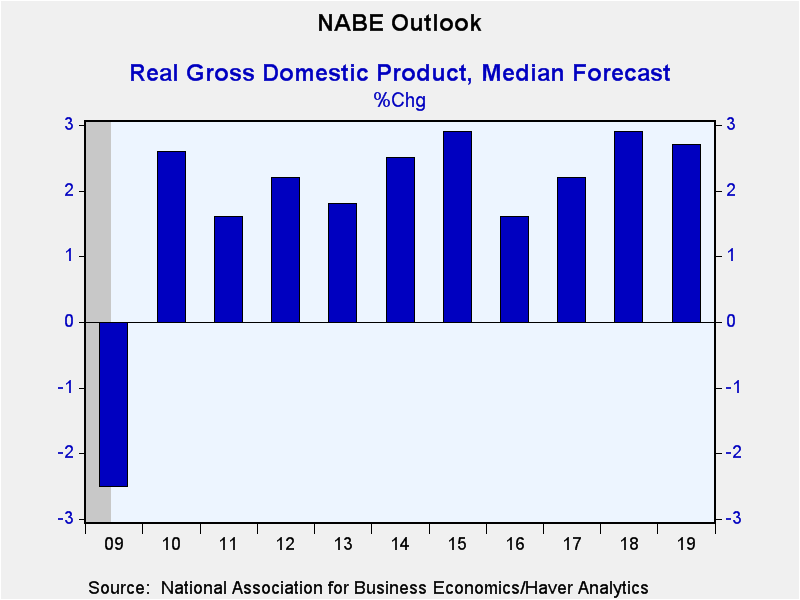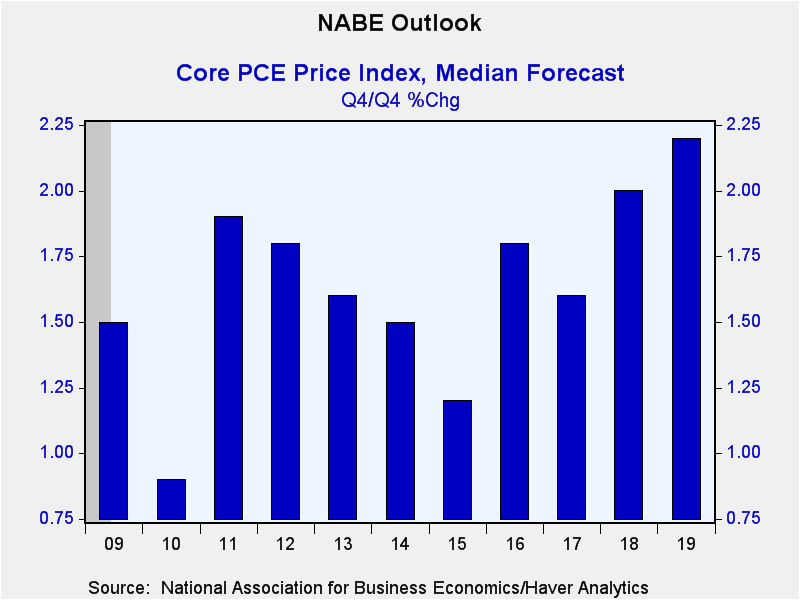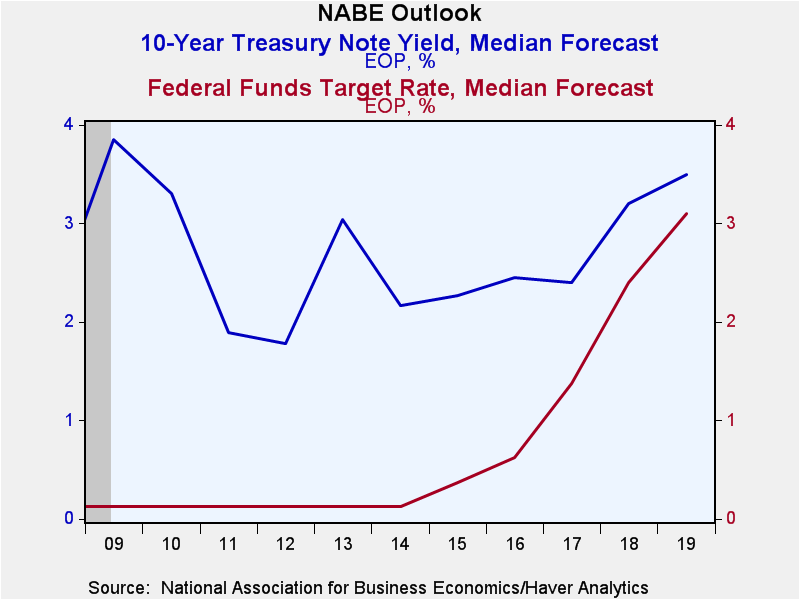 Global| Dec 03 2018
Global| Dec 03 2018NABE 2019 Forecasts of Moderate Growth and Higher Inflation Are Unchanged
by:Tom Moeller
|in:Economy in Brief
Summary
The National Association for Business Economics projects 2.7% growth in real GDP during 2019, unchanged from the prior forecast in June. That follows an expected 2.9% rise this year, revised from the earlier forecast of 2.8% growth. [...]
The National Association for Business Economics projects 2.7% growth in real GDP during 2019, unchanged from the prior forecast in June. That follows an expected 2.9% rise this year, revised from the earlier forecast of 2.8% growth. Quarterly growth is expected to average 2.5% next year following an average 3.1% in 2018. Growth in personal consumption expenditures is forecast to rise an upwardly revised 2.7%, steady with growth this year. Business fixed investment growth of 4.5% should follow a 6.7% advance this year, revised from 5.8%. These are the quickest rates of growth since 2014. Expected growth of 1.4% in residential investment growth was downwardly revised, following little change this year, revised from 3.3%. Government spending growth is projected to remain modest at 2.2%, revised from 1.8%. Deterioration in real net exports is forecast to continue as expected import growth of 4.0% next year outpaces a lessened 2.7% advance in exports. The rate of inventory investment is expected to improve moderately next year, but remain well below the gains from 2012 to 2015.
Housing starts are expected to average a downwardly revised 1.30 million next year, stable with this year's level. Expected light vehicle sales were minimally changed to 16.7 million units in 2019, down from the high of 17.5 million in 2016. Average monthly gains in payroll employment are expected to slow to a little-changed 166,000, down from the 250,000 average in 2014. Expectations for the unemployment rate were lowered to 3.6% from 3.7%, leaving it at the lowest level since 1969.
Consumer price inflation is expected to average a raised 2.4% (Q4/Q4). Price inflation as measured by the PCE price index is expected to average an unrevised 2.1% the same as in 2018 which was unrevised. The chain PCE price index excluding food & energy should rise an upwardly revised 2.2% (Q4/Q4). The cost of crude oil is expected to average $67 per barrel at the end of next year, stable with this year.
The forecasted 3.50% interest rate on 10-year Treasury notes at the end of 2019 was unchanged and compares to an unchanged estimate of 3.20% at the end of this year. The Fed is expected to continue raising the federal funds rate to 3.10% by the end of 2019, revised from 2.88%. Corporate profits after-tax next year should rise a little-changed 4.6% after increased 7.3% growth this year. The expectation for the Federal government budget deficit of $1.005 billion next year was revised up from $987 billion and compares to a $779 billion deficit in 2018, revised from $800 billion.
The figures from the latest NABE report can be found in Haver's SURVEYS database.
Has Inflation Sustainably Reached Target? from the Federal Reserve Bank of San Francisco is available here.
| National Association For Business Economics | 2019 | 2018 | 2017 | 2016 | 2015 |
|---|---|---|---|---|---|
| Real GDP (% Chg. SAAR) | 2.7 | 2.9 | 2.2 | 1.6 | 2.9 |
| Personal Consumption Expenditures | 2.7 | 2.7 | 2.5 | 2.7 | 3.7 |
| Business Fixed Investment | 4.5 | 6.7 | 5.3 | 0.5 | 1.8 |
| Residential Investment | 1.4 | 0.1 | 3.3 | 6.5 | 10.1 |
| Gov't Consumption & Gross Investment | 2.2 | 1.8 | -0.1 | 1.4 | 1.9 |
| Change in Real Business Inventories (Bil. $) | 46.1 | 31.0 | 22.5 | 23.4 | 129.0 |
| Real Net Exports (Bil. $) | -968.5 | -906.9 | -858.7 | -786.2 | -724.9 |
| Housing Starts (Mil. Units) | 1.30 | 1.30 | 1.20 | 1.17 | 1.11 |
| Light Vehicle Sales (Mil. Units) | 16.7 | 17.1 | 17.1 | 17.5 | 17.4 |
| Payroll Employment Average Monthly Change (000s) | 166 | 207 | 182 | 195 | 226 |
| Civilian Unemployment Rate (%) | 3.6 | 3.9 | 4.4 | 4.9 | 5.3 |
| Chain Price Index for PCE (Q4/Q4 %) | 2.1 | 2.1 | 1.8 | 1.6 | 0.3 |
| Chain Price Index excl. Food & Energy (Q4/Q4 %) | 2.2 | 2.0 | 1.6 | 1.8 | 1.2 |
| Fed Funds Rate (%, Year-End) | 3.10 | 2.40 | 1.38 | 0.63 | 0.38 |
| 10-Year Treasury Note (%, Year-End) | 3.50 | 3.20 | 2.40 | 2.45 | 2.27 |
Tom Moeller
AuthorMore in Author Profile »Prior to joining Haver Analytics in 2000, Mr. Moeller worked as the Economist at Chancellor Capital Management from 1985 to 1999. There, he developed comprehensive economic forecasts and interpreted economic data for equity and fixed income portfolio managers. Also at Chancellor, Mr. Moeller worked as an equity analyst and was responsible for researching and rating companies in the economically sensitive automobile and housing industries for investment in Chancellor’s equity portfolio. Prior to joining Chancellor, Mr. Moeller was an Economist at Citibank from 1979 to 1984. He also analyzed pricing behavior in the metals industry for the Council on Wage and Price Stability in Washington, D.C. In 1999, Mr. Moeller received the award for most accurate forecast from the Forecasters' Club of New York. From 1990 to 1992 he was President of the New York Association for Business Economists. Mr. Moeller earned an M.B.A. in Finance from Fordham University, where he graduated in 1987. He holds a Bachelor of Arts in Economics from George Washington University.










